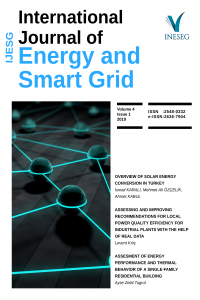DESIGN OF P&O AND FL BASED MPPT CONTROLLERS OF PV ARRAY BY USING POSITIVE SUPER LIFT DC/DC BOOST CONVERTER
converter, fuzzy logic, perturb and observation, solar energy
DESIGN OF P&O AND FL BASED MPPT CONTROLLERS OF PV ARRAY BY USING POSITIVE SUPER LIFT DC/DC BOOST CONVERTER
converter, fuzzy logic, perturb and observation, solar energy,
___
- W. Nsengiyumva, S. G. Chen, L, Hu, X. Chen, “Recent advancements and challenges in Solar Tracking Systems (STS): A review”, Renewable and Sustainable Energy Reviews, 81, 250-279, 2018.
- Y. Zhu, J. Liu, X. Yang, “Design and performance analysis of a solar tracking system with a novel single-axis tracking structure to maximize energy collection”, Applied Energy, 264 (114647), 2020.
- F. Dinçer, “The analysis on photovoltaic electricity generation status, potential and policies of the leading countries in solar energy”, Renewable and Sustainable Energy Reviews, 15 (1), 713–720, 2011.
- J. Yu, Y.M. Tang, K.Y. Chau, R.. Nazar, S. Ali, W. Iqbal, “Role of solar-based renewable energy in mitigating CO2 emissions: Evidence from quantile-on-quantile estimation”, Renewable Energy, 182, 216-226, 2022.
- A. Rahman, O. Farrok, M.M. Haque, “Environmental impact of renewable energy source based electrical power plants: Solar, wind, hydroelectric, biomass, geothermal, tidal, ocean, and osmotic”, Renewable and Sustainable Energy Reviews, 161, 2022.
- Z. Gumus, M. Demirtas, “Comparison of the algorithms used in maximum power point tracking in photovoltaic systems under partial shading conditions”, Journal of Polytechnic, 24(3), 853-865, 2021.
- S.Adak, H.Cangi, B.Eid and A.S.Yilmaz, “Developed analytical expression for current harmonic distortion of the PV system's inverter in relation to the solar irradiance and temperature”, Electric. Eng., 1031, 103 (1), 697-704, Oct. 2020.
- C. Haydaroglu, B. Gumus, “Examination of web-based pvgis and sunny design web photovoltaic system simulation programs and assessment of reliability of the results”, Journal of Engineering and Technology, 32-38, 2017.
- R.. Das, K.M. Rahman, "Effect of response time and starting point of duty cycle in maximum power point tracking operation of solar panel using PO algorithm," 2016 9th International Conference on Electrical and Computer Engineering (ICECE), 357-360, 2016.
- L. P. N. Jyothy and M. R. Sindhu, “An artificial neural network based mppt algorithm for solar pv system,” in 2018 4th International Conference on Electrical Energy Systems (ICEES), 375–380, 2018.
- M. Zerouali, S. Zouirech, A.E. Ougli, B. Tidhaf, H. Zrouri, "Improvement of conventional mppt techniques P&O and INC by integration of fuzzy logic," 2019 7th International Renewable and Sustainable Energy Conference (IRSEC), 1-6, 2019.
- A.S. Tekade, R. Juneja, M. Kurwale, P. Debre, "Design of positive output super-lift luo boost converter for solar inverter," 2016 International Conference on Energy Efficient Technologies for Sustainability (ICEETS), 153-156, 2016.
- N. Silpa, J. Chitra, “An improved luo converter for high voltage applications,” International Journal of Emerging Technology and Advanced Engineering, 4(5), May 2014.
- S.S. Dheeban, N.B. Muthu Selvan, L. Krishnaveni, “Performance improvement of Photo-Voltaic panels by Super-Lift Luo converter in standalone application”, Materials Today: Proceedings, 37, 1163-1171, 2021.
- C.H. Basha, C. Rani, “Diferent conventional and soft computing mppt techniques for solar pv systems with high step-up boost converters: a comprehensive analysis”, Energies,13(1), 371, 2020.
- M.A. Vildirim, M. Nowak-Ocłoń, “Maximum power point tracking algorithm under time-varying solar irradiation”, Energies, 13, 6722, 2020.
- M. İ. Ort, “PV sistemlerde güneşi takip eden sistem tasarımı ve mppt kontrolu ile enerjinin yuke maksimum olarak aktarılması”, İstanbul Technical Uni., Fen Bilimleri Enst., MSs, s. 52, Istanbul, 2016.
- T. L. Kottas, S. B. Yiannis, D. K. Athanassios "New maximum power point tracker for PV arrays using fuzzy controller in close cooperation with fuzzy cognitive networks" IEEE Transactions on Energy Conversion, 21(3), 793-803, 2016.
- M.A.A. Mohd Zainuri, M.M. Mohd Radzi, A.C. Soh, N. Rahim, "Adaptive P&O-fuzzy control mppt for pv boost dcdc converter." 2012 IEEE Int. Conf. on Power and Energy, pp. 524-529, 2012.
- D. Haji, N. Genc, “Fuzzy and P&O Based MPPT Controllers under Different Conditions”, 7th Int. Conf. on Renewable Energy Research and Applications (ICRERA), 14-17 Oct., 649-655, 2018.
- ISSN: 2548-0332
- Başlangıç: 2016
- Yayıncı: Zülküf GÜLSÜN
VIRTUAL POWER PLANT SOLUTION FOR KENYA RURAL ENERGY NEEDS
Obed Nelson ONSOMU, Bülent YEŞİLATA
RENEWABLE ENERGIES IN THE SETTLEMENTS (A STEP TOWARD A CLEAN CITY)
Aıdın ARMANFAR, Mahsa KHANMOHAMMADI
DESIGN IMPROVEMENT OF A 2 MVA SYNCHRONOUS MACHINE BY USING PARTICLE SWARM OPTIMIZATION
